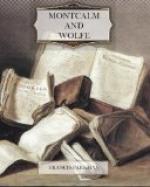The fleet was gone; the great river was left a solitude; and the chill days of a fitful November passed over Quebec in alternations of rain and frost, sunshine and snow. The troops, driven by cold from their encampment on the Plains, were all gathered within the walls. Their own artillery had so battered the place that it was not easy to find shelter. The Lower Town was a wilderness of scorched and crumbling walls. As you ascend Mountain Street, the Bishop’s Palace, on the right, was a skeleton of tottering masonry, and the buildings on the left were a mass of ruin, where ragged boys were playing at seesaw among the fallen planks and timbers.[815] Even in the Upper Town few of the churches and public buildings had escaped. The Cathedral was burned to a shell. The solid front of the College of the Jesuits was pockmarked by numberless cannon-balls, and the adjacent church of the Order was wofully shattered. The church of the Recollects suffered still more. The bombshells that fell through the roof had broken into the pavement, and as they burst had thrown up the bones and skulls of the dead from the graves beneath.[816] Even the more distant Hotel-Dieu was pierced by fifteen projectiles, some of which had exploded in the halls and chambers.[817]
[Footnote 815: Drawings made on the spot by Richard Short. These drawings, twelve in number, were engraved and published in 1761.]
[Footnote 816: Short’s Views in Quebec, 1759. Compare Pontbriand, in N.Y. Col. Docs., X. 1,057.]
[Footnote 817: Casgrain, Hotel-Dieu de Quebec, 445.]
The Commissary-General, Berniers, thus describes to Bourlamaque the state of the town: “Quebec is nothing but a shapeless mass of ruins. Confusion, disorder, pillage reign even among the inhabitants, for the English make examples of severity every day. Everybody rushes hither and thither, without knowing why. Each searches for his possessions, and, not finding his own, seizes those of other people. English and French, all is chaos alike. The inhabitants, famished and destitute, escape to the country. Never was there seen such a sight."[818]
[Footnote 818: Berniers a Bourlamaque, 27 Sept. 1759.]
Quebec swarmed with troops. There were guardhouses at twenty different points; sentinels paced the ramparts, squads of men went the rounds, soldiers off duty strolled the streets, some in mitre caps and some black three-cornered hats; while a ceaseless rolling of drums and a rigid observance of military forms betrayed the sense of a still imminent danger. While some of the inhabitants left town, others remained, having no refuge elsewhere. They were civil to the victors, but severe towards their late ruler. “The citizens,” says Knox, “particularly the females, reproach M. Vaudreuil upon every occasion, and give full scope to bitter invectives.” He praises the agreeable manners and cheerful spirit of the Canadian ladies,




